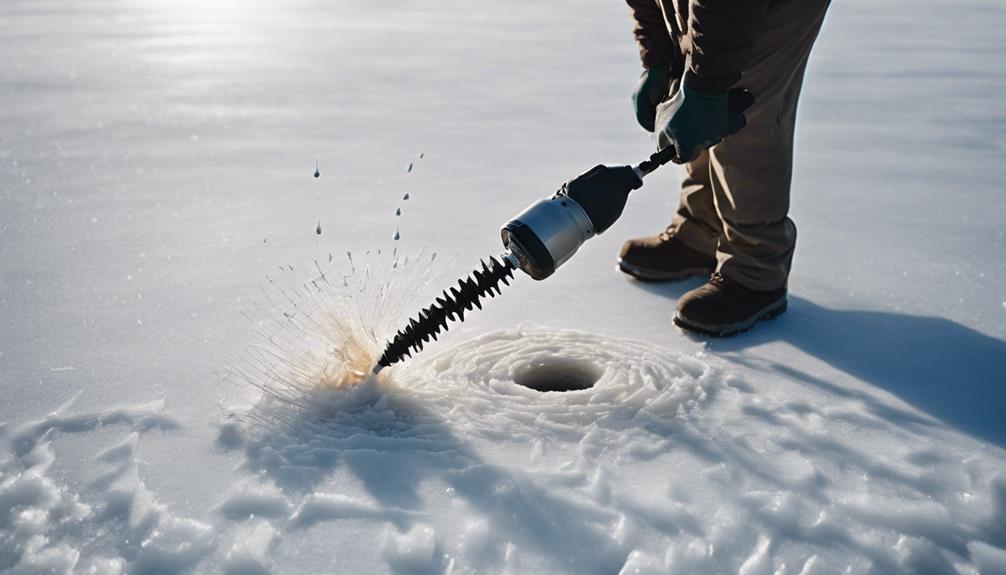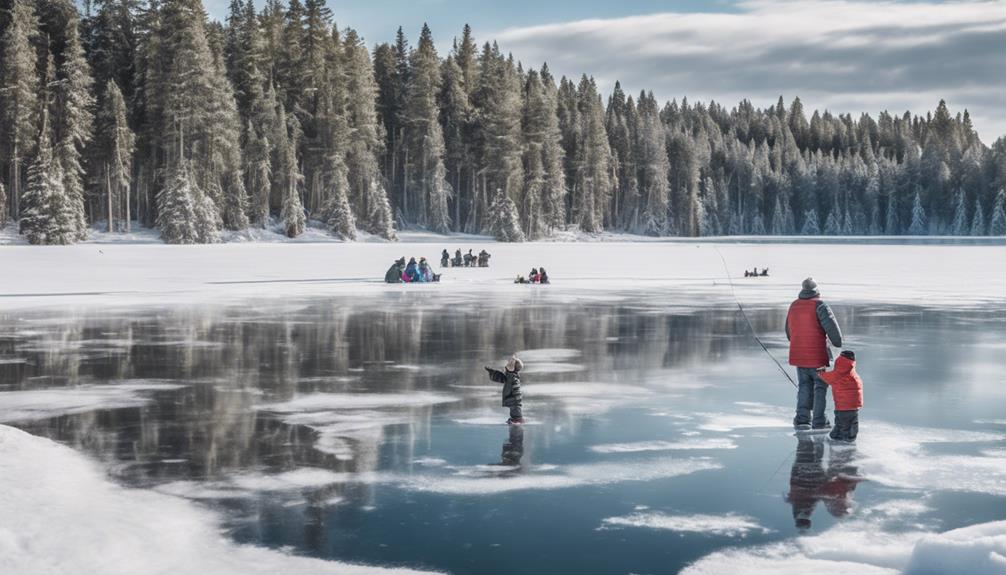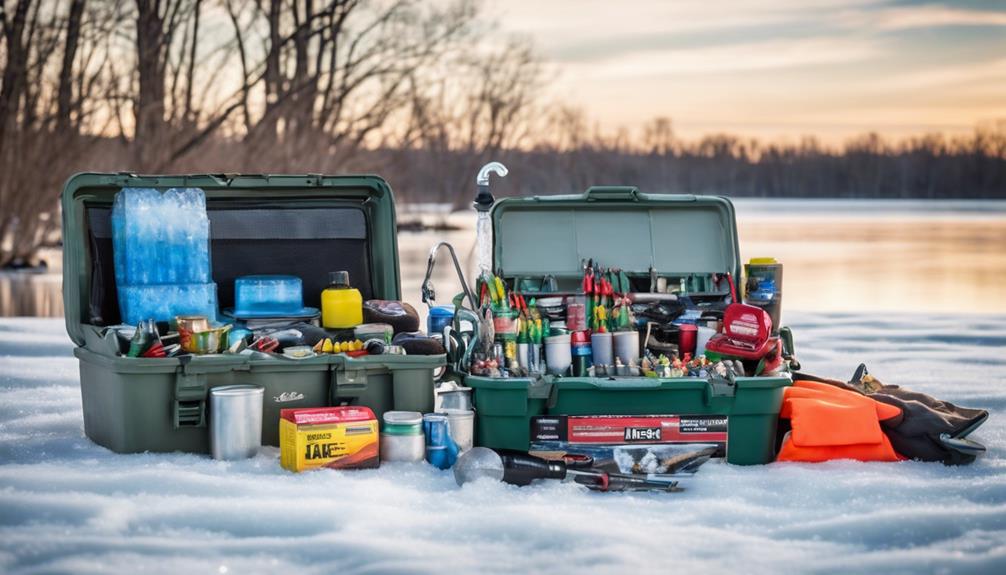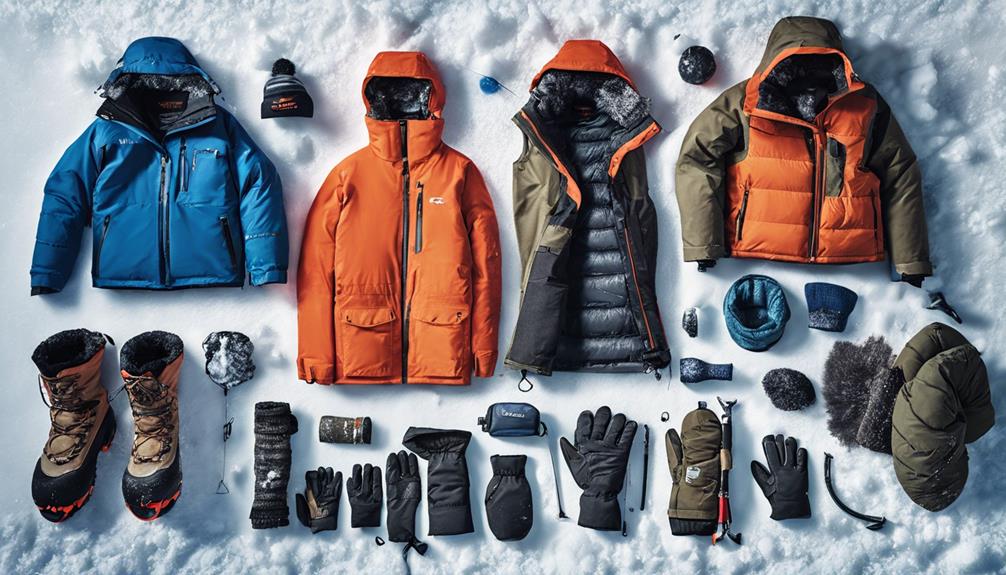When it comes to ice fishing, ensuring the quality of your drilled holes can significantly impact your overall experience on the ice.
From selecting the right tools to mastering drilling techniques, there are several key pro tips that can elevate your ice fishing game.
By understanding the nuances of ice conditions and implementing strategic drilling methods, you can enhance your chances of success out on the frozen waters.
But that's just the beginning – there's much more to uncover when it comes to drilling perfect ice fishing holes.
Proper Equipment Selection
Are you wondering what equipment you need for successful ice fishing? Well, let's dive into the essentials.
First and foremost, equipment maintenance is key to a productive ice fishing trip. Before heading out, check your gear for any signs of wear and tear. Make sure your ice auger is sharp and in good working condition to drill through the thick ice efficiently. Inspect your fishing rods, reels, and lines to ensure they're in top shape for battling those cold-water beasts.
Safety gear is non-negotiable when it comes to ice fishing. One crucial piece of safety equipment is a set of ice picks. These handy tools can help you pull yourself out of the water if you accidentally fall through the ice. Additionally, wearing a floatation suit is highly recommended, especially when venturing onto uncertain ice conditions. It provides an extra layer of safety in case of an emergency.
Understanding Ice Thickness
To properly assess the safety of the ice for ice fishing, ensure a thorough understanding of ice thickness. Measuring depth is crucial in determining whether the ice is safe to support your weight and gear. As a rule of thumb, at least 4 inches of clear, solid ice is generally considered safe for ice fishing. However, it's essential to remember that ice thickness can vary across a body of water due to factors like currents, springs, and pressure ridges. Always use an ice auger or an ice chisel to check the thickness as you move further onto the ice.
Safety precautions should always be a top priority when venturing onto the ice. Before heading out, make sure to inquire locally about the current ice conditions. It's recommended to wear a life jacket or a floatation suit as an added safety measure. Additionally, carrying ice picks, a throw rope, and a whistle can be lifesaving tools in case of an emergency. Avoid taking unnecessary risks, especially if you're unsure about the ice conditions. Remember that no fish is worth compromising your safety.
Locating Ideal Fishing Spots
When scouting for ideal fishing spots while ice fishing, look for areas with underwater structures such as submerged trees or rock formations. These structures provide hiding spots for fish and attract smaller aquatic creatures, making them prime locations for fishing. Understanding depth perception is crucial; fish tend to swim at different depths depending on factors like water temperature and available food sources. In colder months, fish often seek warmer waters, so locating areas where sunlight penetrates the ice can lead to successful catches.
Consider fish behavior when choosing a fishing spot. Predatory fish like pike and walleye may be found near drop-offs or ledges where they can ambush their prey. On the other hand, panfish such as perch or bluegill prefer shallower waters near vegetation. By observing fish behavior and adapting your fishing strategy accordingly, you can increase your chances of a successful ice fishing outing.
Additionally, pay attention to underwater currents or inflows that can bring in nutrients and attract fish. Holes drilled near these areas can be excellent fishing spots. Once you've identified potential locations based on underwater structures, depth perception, and fish behavior, you'll be well on your way to drilling perfect ice fishing holes in the most promising spots.
Preparing the Drill
Before drilling your ice fishing hole, gather all the necessary equipment near the chosen spot for efficiency. Ensure you have everything you need within easy reach to streamline the process. Now, let's get your drill ready for action.
Preparing the Drill:
- Drill Maintenance: Before heading out onto the ice, check your drill for any signs of wear and tear. Make sure the blades are sharp and in good condition. It's essential to have a properly functioning drill to make clean and efficient holes in the ice.
- Winter Gear: Dress appropriately for the cold weather to stay comfortable while drilling. Wear insulated gloves to protect your hands from the cold and potential sharp edges. Additionally, ensure you have good traction on your boots to prevent any slips on the icy surface.
- Battery Check: If you're using a battery-powered drill, ensure the battery is fully charged before you start drilling. Cold temperatures can drain batteries faster, so having a backup fully charged battery is a good idea. This will prevent any interruptions in your ice fishing experience due to a drained battery.
Technique for Smooth Drilling
Ready to drill your ice fishing hole like a pro? To ensure smooth drilling, there are a few key techniques to keep in mind. Firstly, make sure your blades are sharp. Dull blades can cause the drill to work harder, leading to a rougher hole surface. Before heading out, give your blades a good sharpening to guarantee a clean cut through the ice.
Next, pay attention to the angle at which you're drilling. Keeping the drill at a perpendicular angle to the ice surface will help you achieve a neat and precise hole. Angling the drill can result in an uneven bottom, making it harder to position your bait correctly.
When it comes to drill speed, a steady pace is essential. Avoid rushing through the drilling process, as going too fast can cause the blades to catch and create jagged edges. On the other hand, drilling too slowly can lead to a sluggish progression through the ice. Find a balance that allows the blades to cut smoothly without getting stuck.
Lastly, consider the depth of your hole. Knowing how deep you need to drill will prevent you from unnecessarily exerting energy and time. By following these techniques for smooth drilling, you'll be well on your way to creating perfect ice fishing holes every time.
Preventing Ice Chipping
To prevent ice chipping while drilling your fishing hole, maintain a steady downward pressure on the drill. By following these chipping prevention techniques and proper drill maintenance, you can ensure a smooth and clean ice fishing experience.
Chipping Prevention Techniques:
- Steady Pressure: Apply consistent pressure on the drill as you bore through the ice. This helps avoid sudden jerks that can lead to chipping.
- Sharp Blades: Ensure your drill blades are sharp and in good condition. Dull blades can cause the ice to chip rather than cut cleanly.
- Slow and Steady: Drill at a moderate speed, allowing the blades to work through the ice smoothly without causing unnecessary stress on the surrounding area.
Remember, taking care of your equipment is crucial not just for preventing ice chipping but also for the longevity of your tools and gear. Proper ice hole care and equipment storage can make a significant difference in your ice fishing endeavors.
Incorporate these tips into your routine to maintain a clean and neat fishing hole while drilling through the ice. By being mindful of your technique and equipment, you can enjoy a seamless ice fishing experience without the hassle of dealing with chipped ice around your hole.
Safety Measures on Ice
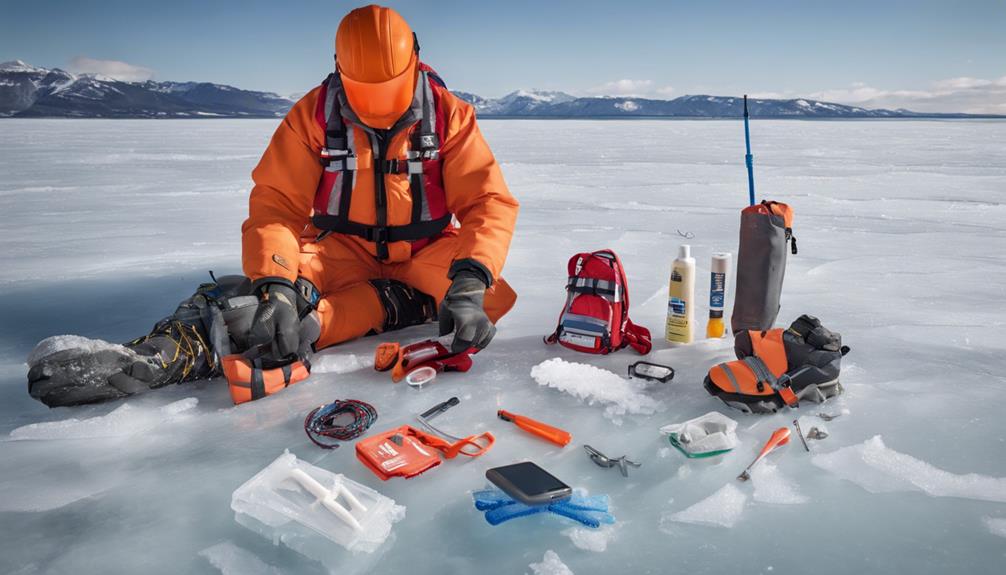
When venturing onto the ice for fishing, prioritize safety by being aware of potential hazards and taking necessary precautions. One essential safety measure is wearing ice cleats on your boots to prevent slips and falls on the icy surface. Ice cleats provide additional traction, reducing the risk of accidents while moving around on the slick ice. Make sure to choose cleats that fit securely on your footwear to ensure they stay in place throughout your fishing excursion.
Additionally, always carry an emergency kit with you when ice fishing. Your emergency kit should include essential items such as a first aid kit, a whistle to signal for help in case of emergencies, extra layers of clothing for warmth, and some high-energy snacks to keep you nourished. Being prepared with an emergency kit can make a significant difference in unforeseen situations, providing you with the necessary tools to handle emergencies effectively.
Maintaining Drill Efficiency
To ensure peak performance when drilling ice fishing holes, regularly clean and sharpen your auger blades for optimal efficiency. Proper drill maintenance is crucial for a successful ice fishing experience.
Here are some essential tips to help you maintain drill efficiency:
- Clean Blades Regularly: Ice shavings and debris can accumulate on the blades, leading to a decrease in drilling speed and efficiency. After each use, make sure to clean the blades thoroughly with a brush or cloth to remove any buildup.
- Sharpen Blades When Dull: Dull blades can make drilling through ice a challenging task. Keep your blades sharp by using a blade sharpener or taking them to a professional sharpening service. Sharp blades will cut through the ice more easily, saving you time and effort on the ice.
- Inspect for Damage: Regularly inspect your auger blades for any signs of damage, such as nicks or bends. Damaged blades can affect the quality of the holes you drill and may even cause the blades to break during use. Replace or repair any damaged blades to maintain optimal drill efficiency.
Frequently Asked Questions
How Can I Stay Warm and Comfortable While Ice Fishing?
To stay warm and comfortable while ice fishing, layering strategies are key.
Start with moisture-wicking base layers, add insulating mid-layers, and finish with a waterproof and windproof outer layer.
Don't forget to pack heat packs in your gloves and boots for extra warmth.
These simple steps will help you enjoy your ice fishing adventure without feeling the chill.
What Types of Bait Are Most Effective for Ice Fishing?
When ice fishing, the best lures to use are small jigs tipped with waxworms or minnow heads. These tend to attract fish like perch, crappie, and bluegill.
Ideal tackle includes an ultralight rod and reel combo, light line, and a selection of different jig sizes and colors to adapt to changing conditions.
Experimenting with different baits and presentations can help you find what works best for the fish in your area.
Can I Use a Regular Drill for Ice Fishing or Do I Need a Specific Ice Auger?
You can use a regular drill for ice fishing, but it's not as efficient as an ice auger. The drill comparison shows that ice augers are designed for the job, making hole drilling quicker and easier.
To maintain your equipment, consider DIY tips like lubricating the blades and cleaning the auger regularly. This will ensure your ice auger lasts longer and performs at its best every time you head out onto the ice.
Are There Any Specific Regulations or Permits Required for Ice Fishing in Certain Areas?
In certain areas, ice fishing may require specific permit requirements and adherence to fishing regulations. It's essential to check with local authorities or fish and wildlife departments to ensure you're in compliance.
Permit requirements can vary based on location and species being fished. Familiarizing yourself with the rules and regulations beforehand will help you have a smooth and enjoyable ice fishing experience.
How Do I Properly Store and Maintain My Ice Fishing Equipment During the Off-Season?
When it comes to storing equipment for the off-season, make sure to clean and dry all your ice fishing gear thoroughly before putting it away.
Store your rods, reels, and tackle in a cool, dry place to prevent rust and damage. For your auger, apply a light coat of oil to prevent corrosion.
Checking your lines for any wear and tear is also a good idea. Proper maintenance now will save you time and hassle next season.
Conclusion
Now that you've learned these pro tips for drilling perfect ice fishing holes, you're ready to hit the ice with confidence.
Remember to select the right equipment, understand ice thickness, locate ideal spots, prepare your drill, use proper technique, prevent chipping, prioritize safety, and maintain drill efficiency.
With these tips in mind, you'll be drilling holes like a pro in no time.
Happy fishing!
